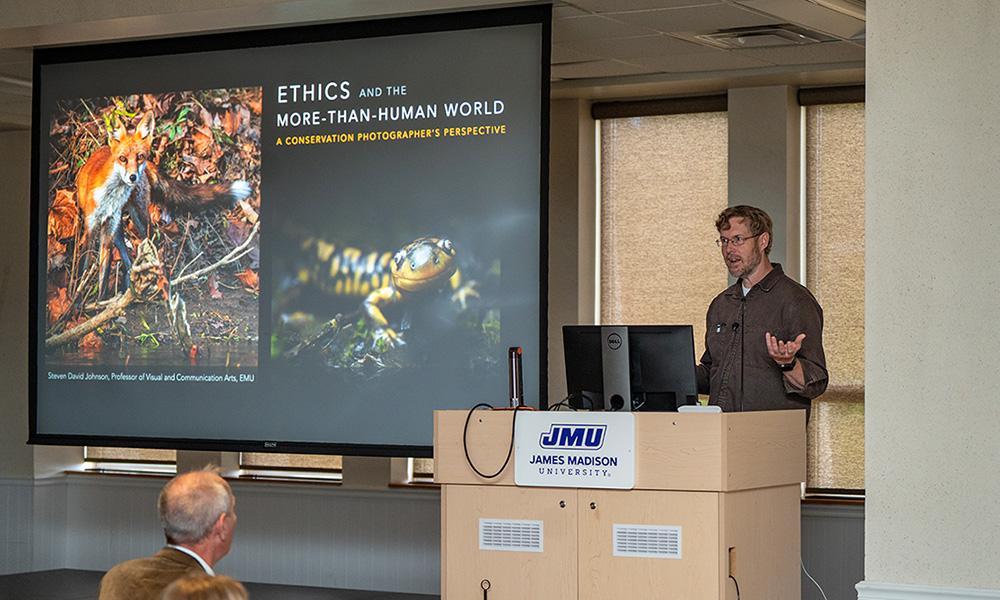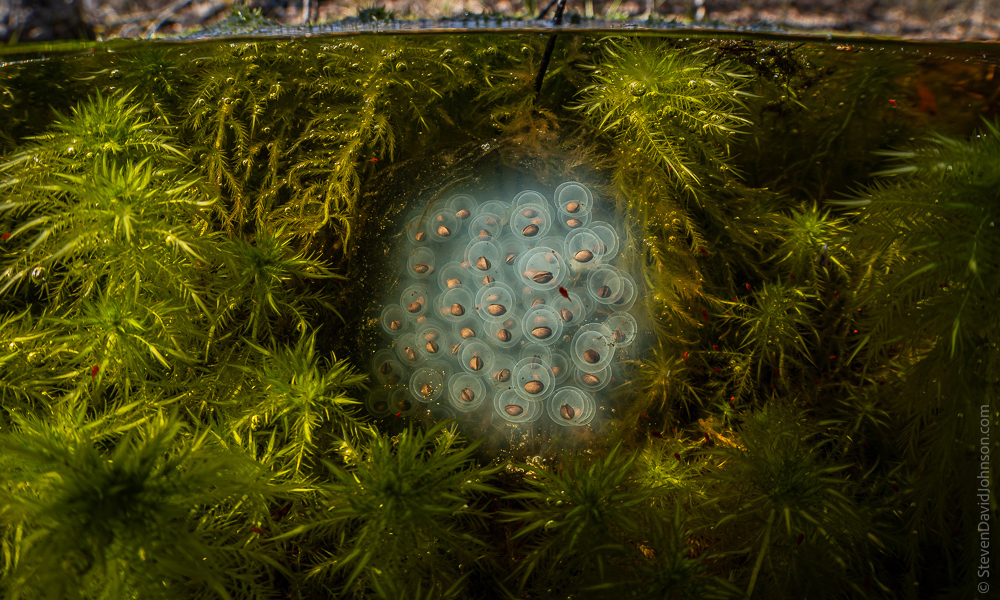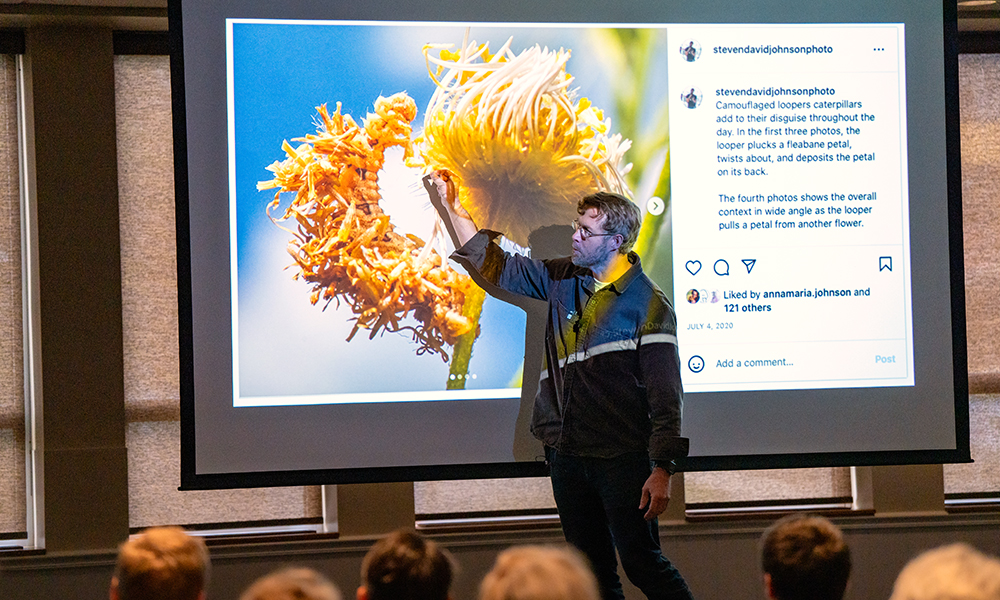Conservation photography is about ‘the big picture’
Featured Stories
SUMMARY: Conservation photographer Steven David Johnson spoke about the “hidden diversity” around the Shenandoah Valley at a recent Elev8 Ethics event. One of his photographs of salamander eggs in a vernal pool earned him a spot among 2023 finalists in the Wildlife Photographer of the Year competition, hosted by the Natural History Museum in London.
Nature photographer Steven David Johnson has long shone a quiet spotlight on the natural world of “hidden diversity” just outside of Harrisonburg.
“Conservation photography is nature photography, plus,” he said. “It’s using nature photography for environmental advocacy, and it’s also an ecosystems approach — looking at the bigger picture.
“Practicing this discipline has become a way of protecting and giving back to the life and the landscapes that sustain me.”
Speaking on “Ethics and the More-Than Human World” as part of Ethical Reasoning in Action’s Elev8 Ethics series, Johnson, a professor of visual and communication arts at Eastern Mennonite University, shared images of the biodiversity he has found below the surface of vernal pools around the Shenandoah Valley.
Vernal pools are temporary bodies of water that form in seasonal wetlands after significant rain or snowmelt, he explained. “The fact that they’re temporary makes them fish-free, and that promotes ideal breeding environments for various types of amphibians and macroinvertebrates.”

Johnson’s nature photography has appeared in numerous conservation publications and journals, and his photo of a luminescent cluster of salamander eggs was a 2023 finalist in the Wildlife Photographer of the Year competition, hosted by the Natural History Museum in London.
“[The eggs] can be otherworldly in their abstract beauty,” Johnson said. “They’re just little worlds that are out there, edged with these delicate blue halos.”
|
“You literally can’t go to another place in the world that has more salamander diversity than where we are in the southeastern United States.” |
For more than a decade, Johnson’s work has highlighted a world many haven’t seen and might not know existed. “Central and southern Appalachia is a biodiversity hotspot for salamanders,” he said. “We have more than 50 species of salamanders just in Virginia. And I think a lot of people don’t know that.”
Calling them “hidden dragons,” he said, “You literally can’t go to another place in the world that has more salamander diversity than where we are in the southeastern United States.”
Johnson supports advocacy and natural history through his devotion to photographing little-seen areas and his partnerships with environmental organizations to promote education.
He partnered with the North American Nature Photography Association and Virginia vernal pools expert Mike Hayslett to release a handbook about vernal pools, collaborated with The Nature Conservancy and writer Lindsay Wiles on a cover story about vernal pools, and contributed to a children’s education feature for Ranger Rick magazine, published by the National Wildlife Federation.
“Conservation photography also makes use of technology to reveal things that are difficult to see with the unassisted eye, like the motion of insect wings or the details of a jumping spider,” Johnson said. “Jumping spiders are highly intelligent. In fact, studies have shown that they can even plan, so if you put them in a kind of controlled experiment, and they see food across the way, they’ll actually plan out their path to get there.”

In addition to insects, amphibians and invertebrates, Johnson photographs larger animals like cranes, beavers, otters, muskrats and minks.
Stressing the importance of biodiversity, he noted there are an estimated 7.7 million different species on earth, meaning a person would need to witness 77,000 species to see even 1%. When it comes to plants and fungi, there are 8.7 million species, “and that’s not even including microorganisms,” he said.
|
“One of my questions ethically is, ‘When we think about all those millions of other species, what does it mean to be a good neighbor to the more-than human world?’” |
“It’s obvious the earth doesn’t exist for us alone,” Johnson said. And yet, humans have an immense impact on the world.
That’s why it’s also important to consider shifting baseline syndrome, a concept he illustrated through the modern-day prevalence of the beaver — a creature that only a century ago had nearly gone extinct.
“It’s amazing that they’re here,” Johnson said. “They’re ecosystem engineers, but if you were in Virginia 100 years ago, you wouldn’t see a beaver, because most beavers were wiped out from the lower 48 states because they were made into hats.”
Society shifted, the beaver hat fell out fashion, policy changes were enacted and, in the 1930s, beavers were reintroduced into Virginia. “So now I can go out and kayak and spend time with these amazing creatures,” he said. “But I think it’s important to know that that was an intentional kind of turning around by human beings making different decisions. They weren’t always here.”

Another concern for today’s world is anthropocentrism — “a lens that we often use to see the world where everything else becomes a means to an end.” It downgrades anything that isn’t immediately important to people and their everyday lives.
“One of my questions ethically is, ‘When we think about all those millions of other species, what does it mean to be a good neighbor to the more-than human world?’” Johnson said.
For example, in addressing the ethics of killing invasive species to preserve indigenous species, he said it’s important to consider the kind of obligations we have when it comes to wild animals. Doing so can raise ethical concerns, even if there aren’t any good or obvious solutions.
“We’re in the middle of an extinction crisis,” Johnson said, “but addressing it doesn’t have to be this thing that’s dreary. It can be an opportunity to witness beauty and develop deep relationships.”
Before his family built a backyard habitat, Johnson never knew of a caterpillar called the camouflaged looper. “I saw this flower that looked like it had come alive. … And all day long, it plucks little petals off the flowers and places them on its back to camouflage itself. Amazing.”
